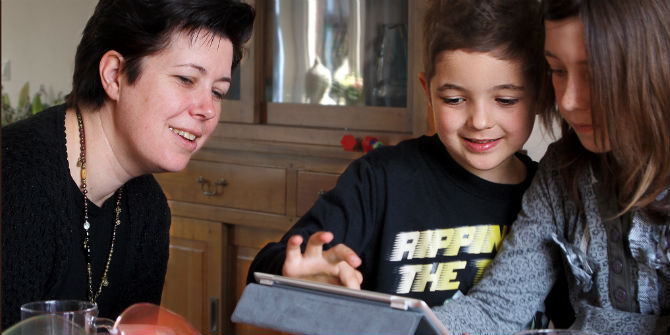 The UK government has recently updated its sex education guidelines. However they still fail to address important digital topics, such as sexting and online sexual harassment, in enough depth. In this post Jessica Ringrose, Amelia Jenkinson and Sophie Whitehead discuss how their policy on Technologically Facilitated Sexual Violence and Digital Defence lessons, aim to help address this gap. Jessica is a Professor of the Sociology of Gender and Education at University College London Institute of Education. Amelia is a Director and Co-Founder and Sophie is a facilitator at Sexplain, an organisation which supports schools to provide age-appropriate, up-to-date & inclusive sex and relationships education programmes. [Header image credit: CC0 Photo by Kaboompics.com from Pexels]
The UK government has recently updated its sex education guidelines. However they still fail to address important digital topics, such as sexting and online sexual harassment, in enough depth. In this post Jessica Ringrose, Amelia Jenkinson and Sophie Whitehead discuss how their policy on Technologically Facilitated Sexual Violence and Digital Defence lessons, aim to help address this gap. Jessica is a Professor of the Sociology of Gender and Education at University College London Institute of Education. Amelia is a Director and Co-Founder and Sophie is a facilitator at Sexplain, an organisation which supports schools to provide age-appropriate, up-to-date & inclusive sex and relationships education programmes. [Header image credit: CC0 Photo by Kaboompics.com from Pexels]
Earlier this year new guidance for Relationships Education, Relationships and Sex Education (RSE) and Health Education for England was put out for consultation by the Department for Education. This draft statutory guidance is intended to upgrade the nearly 20-year-old previous advice from the year 2000.
It highlights the current challenges of the digital context and the essential fact that “for many young people the distinction between the online world and other aspects of life is less marked than for some adults” (page 9). This is referenced throughout, in the context of healthy relationships, respectful behaviour and consent. The importance of digital literacy skills is emphasised for both primary and secondary (see paragraphs 58, 62 and ‘Online and Media’ section of secondary table, p28).
While I (Jessica Ringrose) told the New York Times earlier in the year that the guidelines looked promising and, “It will be really great if they will be able to tackle all these issues” we, the three authors of this blog post, remain concerned that there are serious omissions and that the guidelines fail to address important digital topics in enough depth or detail.
Take pornography, for instance, which is often one of young people’s main sex educators. This topic is inadequately covered due to discomfort, lack of training and safeguarding concerns which end up ignoring children’s sexual health and sexual rights to knowledge and information about their bodies and relationships. Other issues that are not tackled properly include image-based online abuse (such as ugly comments on appearance), technology facilitated sexual harassment and digital flashing. These are all being raised increasingly by young people as everyday matters they must navigate. Also concerning is the fact that problematic sexting resources and films (‘Tagged’ and ‘Exposed’) that have been critiqued internationally as sexist, victim-blaming and slut shaming are still listed as key recommended resources in the sexting guidance.
It is essential to tackle these matters, as digital spaces are a formative part of young people’s relationships, sexuality and understanding of sexual health and consent. Yet despite over a decade of research on youth sexting in the UK, we do not seem to have made much progress in developing appropriate resources for schools.
Looking back, the first UK sexting study was conducted in 2009 by Andy Phippen – a survey of 535 young people aged 11-18 – that found:
- 56% of respondents were aware of instances where images and videos were distributed further than the intended recipient but only 23% believe this distribution is intended to cause upset.
- 30% of young people knew people who had been adversely affected by sexting.
In 2011, Jessica Ringrose and colleagues released a report for the NSPCC drawing on in-depth qualitative data on sexting scenarios which found overwhelming evidence of sexual double standards, victim blaming and slut shaming facing girls in particular. There was little to no awareness amongst young people about how issues of sexual consent extend to the digital sphere, and minimal understanding of laws that criminalise sexually explicit image exchange for under 18s.
In 2019 the first study looking at UK young people’s needs around sexting education has shown a total mismatch between parent and teacher understandings and efforts at education around sexting and young people’s actual needs. The report shows that existing UK resources and strategies for addressing sexting, such as holding assemblies, are judged completely ineffective by young people at offering useful help and support around the complexity of issues of sexting and particularly the problems of lack of consent in the digital sphere.
So although 10 years have passed since Phippen’s initial research into youth sexting in the UK, we are still in the worrying state reported in the 2016 House of Commons Women and Equalities Committee’s inquiry into sexual harassment and violence in schools that found schools’ policies, curriculum, training, practice and delivery are failing to support young people’s safety and well-being around digital sexual health and well-being.
Given this gap, Jessica Ringrose and Kaity Mendes (University of Leicester) have teamed up with the charity Sexplain to develop a policy on Technologically Facilitated Sexual Violence, the first of its kind for schools. It aims to support schools to identify and understand how sexual violence can operate in online spaces, highlight relevant laws and related policies, and to suggest how to create a whole-school approach to tackling this problem. We are also designing a series of ‘digital defence’ lessons, which help young people to manage issues they are facing online: this ranges from targeted advertising and cyberbullying to self-care strategies for teen digital feminist activists.
Moving forward, we are also working with a larger group of academics and charities to delve into the current realities of youth digital intimacies and uses of social media and image circulation through a new research project, ‘Sexting 10 Years On’. Findings are to be released in 2020. There will be a new focus on masculinity and issues of digital consent, in response to international research which has found a significant rise in the production and circulation of ‘dick pics’ while girls face more harmful consequences from non-consensual image sharing whether that be images of girls’ body parts passed without consent or receiving non-consensual pictures of male body parts.
This redirection into masculinity and image sharing and issues of consent and the law is important to shift the focus away from girls as main producers and victims of sexting and to consider in depth how boys are participating in online image sharing.
Notes
This text was originally published on the IOE London blog and has been re-posted here with permission.
This post gives the views of the authors and does not represent the position of the LSE Parenting for a Digital Future blog, nor of the London School of Economics and Political Science.







